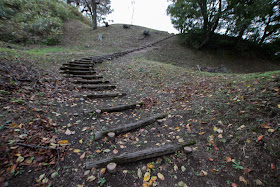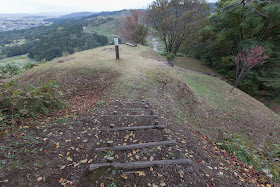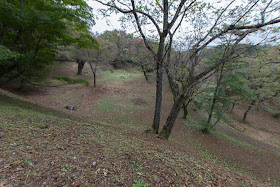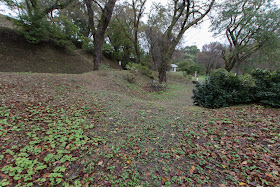Mikaburi Castle
-Quiet castle like a miniature Japanese garden-
Overview
Name: Mikaburi castle (Mikaburi-jo)
Alias:
Place: Nakanomiya Itakura-ku Jyoetsu city, Niigata
Location: 37.02668705706011, 138.30474839168056
Type: Mountain Castle
Built: 15th century
Remnants: Clay walls and dry moats
Title:
Mikaburi castle (箕冠城) is located at the top of Mikaburiyama mountain, one of 240 meter height in the south part of Joetsu city. Castle site places at the southeast edge of Joetsu plain, a large flat area in the southwestern part of Niigata prefecture. From castle site whole shape of Joetsu plain is well seen.
Joetsu plain was a stronghold of Uesugi clan which was the lord of Echigo province (Niigata prefecture), and only 10 kilometer away from south edge of the basin there was a border to next Shinano province (Nagano prefecture). There are several lords connect Jyoetsu basin and Shinano province, and Uesugi clan built castles around this area both for invasion and protection.
From south edge of Jyoetsu plain, three roads continues southward toward current Nagano prefecture. The western one is a route which directly runs toward Nagano area passing Myoko highland, applicable to current Route 18. The center one is a road diverged from western route, curved to southeast ward, passing hills and reaches to Iiyama area which is now Route 292.
The eastern one starts from current Itakura area of Jyoetsu city and passes Sekitatoge path then down to the north of Iiyama area. Uesugi clan built Nomine castle at the merging point of western and center one, and also Mikaburi castle between center road and eastern route to manage these roads.
Precise year is unknown but Mikaburi castle might be built in the latter half of 15th century, as it differs from old style medieval castle which simply lines up terraces along the ridge. The origin of Okuma clan is also unknown but they were originally a retainer of original Uesugi clan, the high class retainer of Muromachi Shogunate and held the position of Kanto Kanrei, the general governor of Kanto region to support Kanto Kubo, the representative of Muromachi Shogunate at Kanto region.
In Muromachi era, Echigo province had been a territory of Uesugi clan. Uesugi clan appointed Nagao clan as a deputy governor. Okuma clan had been good at calculation and management as a tradition, and served to Uesugi clan as a finance officer. But Uesugi clan and Nagao clan gradually became hostile, and in 1507 Tamekage Nagao (1489-1543), the leader of Nagao clan and father of famous warlord Kenshin Uesugi (1530-1578), rebelled to Uesugi clan and deprived authority of the governor.
Tamakage became the virtual governor of Echigo province, but could not manage the conflict of local lords well and retired in 1536. Harukage Nagao (1509-1553) who was the eldest son of Tamekage succeeded Tamakage but also was not able to improve the situation. Several local lords disappointed with Harukage became to support Kenshin Uesugi who showed brilliant military sense and later was called as a god of war, then finally Kenshin became the leader of Echigo province in 1548.
Under this transition of authority from Uesugi clan to Nagao clan, Tomohide Okuma (?-1582), the leader of Okuma clan, activated at finance for both clan. Tomohide supported the succession of Kenshin, then Tomohide was entrusted by Kenshin.
Type: Mountain Castle
Built: 15th century
Remnants: Clay walls and dry moats
Title:
Brief History
Mikaburi castle (箕冠城) is located at the top of Mikaburiyama mountain, one of 240 meter height in the south part of Joetsu city. Castle site places at the southeast edge of Joetsu plain, a large flat area in the southwestern part of Niigata prefecture. From castle site whole shape of Joetsu plain is well seen.
Border roads and castles
Joetsu plain was a stronghold of Uesugi clan which was the lord of Echigo province (Niigata prefecture), and only 10 kilometer away from south edge of the basin there was a border to next Shinano province (Nagano prefecture). There are several lords connect Jyoetsu basin and Shinano province, and Uesugi clan built castles around this area both for invasion and protection.
From south edge of Jyoetsu plain, three roads continues southward toward current Nagano prefecture. The western one is a route which directly runs toward Nagano area passing Myoko highland, applicable to current Route 18. The center one is a road diverged from western route, curved to southeast ward, passing hills and reaches to Iiyama area which is now Route 292.
The eastern one starts from current Itakura area of Jyoetsu city and passes Sekitatoge path then down to the north of Iiyama area. Uesugi clan built Nomine castle at the merging point of western and center one, and also Mikaburi castle between center road and eastern route to manage these roads.
Family of accounting skill
Precise year is unknown but Mikaburi castle might be built in the latter half of 15th century, as it differs from old style medieval castle which simply lines up terraces along the ridge. The origin of Okuma clan is also unknown but they were originally a retainer of original Uesugi clan, the high class retainer of Muromachi Shogunate and held the position of Kanto Kanrei, the general governor of Kanto region to support Kanto Kubo, the representative of Muromachi Shogunate at Kanto region.
In Muromachi era, Echigo province had been a territory of Uesugi clan. Uesugi clan appointed Nagao clan as a deputy governor. Okuma clan had been good at calculation and management as a tradition, and served to Uesugi clan as a finance officer. But Uesugi clan and Nagao clan gradually became hostile, and in 1507 Tamekage Nagao (1489-1543), the leader of Nagao clan and father of famous warlord Kenshin Uesugi (1530-1578), rebelled to Uesugi clan and deprived authority of the governor.
Finance minister supported god of war
Tamakage became the virtual governor of Echigo province, but could not manage the conflict of local lords well and retired in 1536. Harukage Nagao (1509-1553) who was the eldest son of Tamekage succeeded Tamakage but also was not able to improve the situation. Several local lords disappointed with Harukage became to support Kenshin Uesugi who showed brilliant military sense and later was called as a god of war, then finally Kenshin became the leader of Echigo province in 1548.
Under this transition of authority from Uesugi clan to Nagao clan, Tomohide Okuma (?-1582), the leader of Okuma clan, activated at finance for both clan. Tomohide supported the succession of Kenshin, then Tomohide was entrusted by Kenshin.
Tomohide became a finance minister of Kenshin and supported his campaigns, and Kenshin let Tomohide significantly expand his residence Mikaburi castle as one of important castles to protect border against Shinano province. When Kenshin visited Kyoto city in 1553, Tomohide guarded Kasugayama castle (Niigata prefecture), the main base of Kenshin, as a caretaker.
Mikaburi castle was built utilizing a peak at the end of narrow height surrounded by two creeks. As Mikaburi mountain is a beautiful corned shaped one, Mikaburi castle is a triangle shape spreads from its peak toward south. Central area of the castle is a square shaped one of 50 meter long and 30 meter wide at the top of the mountain, with a small terrace at east like an entrance. The entrance of this central area might be decorated by stone walls, and several stones remain until now.
Under the central area, several layer of terraces spreads along the southern slope toward halfway where slope becomes once flat. At this point there was a main gate to central area, also might have a large gate and stone wall. A slight ruin of stone wall and large stone basement of the gate still exists at this area. Outside of this main gate, there is a large pond at the flat area. Ahead of this pond, a wide and tall outer clay barrier with dry moat continues over 300 meter over the whole part of the slope.
A beautiful corned shape core area with the pond seems as if it is a beautiful miniature Japanese garden. Of course it is not only beautiful, but also a practical one with many flat areas can store soldiers, plenty water source and secure outer barrier. Total size of Mikaburi castle reached 400 meter and 300 meter long, and considering its square shape this castle had a plenty capacity as a major base of the region. This castle suits to and shows well the importance of Tomohide Okuma, both as an administrative staff and military general under Kenshin Uesugi.
But this fulfilling day of Mikaburi castle and Tomohide Okuma did not long. Even under Kenshin, local lords of Echigo province disputed each other, and as a finance minister Tomohide had to face with economic conflicts among retainers. And Tomohide was originally a retainer of former Uesugi clan, and was unfavorable to the direct retainers of Kenshin.
In 1556, Kenshin who got wed with continuing disputed between local lords suddenly traveled to Kyoto city and declared to became a monk. It is said that this was a play to manage non obedient retainers, but Tomohide could not trust Kenshin and other retainers any more.
Structure of Mikaburi castle
Mikaburi castle was built utilizing a peak at the end of narrow height surrounded by two creeks. As Mikaburi mountain is a beautiful corned shaped one, Mikaburi castle is a triangle shape spreads from its peak toward south. Central area of the castle is a square shaped one of 50 meter long and 30 meter wide at the top of the mountain, with a small terrace at east like an entrance. The entrance of this central area might be decorated by stone walls, and several stones remain until now.
Under the central area, several layer of terraces spreads along the southern slope toward halfway where slope becomes once flat. At this point there was a main gate to central area, also might have a large gate and stone wall. A slight ruin of stone wall and large stone basement of the gate still exists at this area. Outside of this main gate, there is a large pond at the flat area. Ahead of this pond, a wide and tall outer clay barrier with dry moat continues over 300 meter over the whole part of the slope.
A beautiful corned shape core area with the pond seems as if it is a beautiful miniature Japanese garden. Of course it is not only beautiful, but also a practical one with many flat areas can store soldiers, plenty water source and secure outer barrier. Total size of Mikaburi castle reached 400 meter and 300 meter long, and considering its square shape this castle had a plenty capacity as a major base of the region. This castle suits to and shows well the importance of Tomohide Okuma, both as an administrative staff and military general under Kenshin Uesugi.
Rebellion and turnover
But this fulfilling day of Mikaburi castle and Tomohide Okuma did not long. Even under Kenshin, local lords of Echigo province disputed each other, and as a finance minister Tomohide had to face with economic conflicts among retainers. And Tomohide was originally a retainer of former Uesugi clan, and was unfavorable to the direct retainers of Kenshin. In 1556, Kenshin who got wed with continuing disputed between local lords suddenly traveled to Kyoto city and declared to became a monk. It is said that this was a play to manage non obedient retainers, but Tomohide could not trust Kenshin and other retainers any more.
Under such condition, Shingen Takeda (1521-1573), the warlord of Kai province (Yamanashi prefecture) and a rival of Kenshin struggled for Shinano province, entices Tomohide rebelled against Kenshin. At that year Tomohide finally raised his army against Kenshin, but was defeated and escaped to Ecchu province (Toyama prefecture).
Several years later Shingen Takeda cared about Tomohide invited him. Tomohide at first belonged to the army of Masakage Yamagata (1529-1575), the bravest general of Takeda army. Tomohide activated under Masakage many times, and when Takeda army siege Minowa castle (Gunma prefecture) in 1566, Tomohide was said to intrude into the castle at first and made a even single combat with Nobutsuna Kamiizumi (1508-1577), a legendary swordsman who was the master of Munetoshi Yagyu (1527-1606), the founder of Yagyu Shinkageryu school. As a reward for continuous success of Tomoshige, Shingen promoted him to a general and appointed as a lord of Koyama castle (Shizuoka prefecture).
But calm days of Tomohide did not long again. In 1573 Shingen died in ill at the campaign against central ruler Nobunaga Oda (1534-1582) and his ally Ieyasu Tokugawa (1543-1616). Katsuyori Takeda (1546-1582), the successor of Shingen, desperately fought to countervail to Nobunaga, but suffered a fatal defeat at the battle of Nagashino in 1575.
Several years later Shingen Takeda cared about Tomohide invited him. Tomohide at first belonged to the army of Masakage Yamagata (1529-1575), the bravest general of Takeda army. Tomohide activated under Masakage many times, and when Takeda army siege Minowa castle (Gunma prefecture) in 1566, Tomohide was said to intrude into the castle at first and made a even single combat with Nobutsuna Kamiizumi (1508-1577), a legendary swordsman who was the master of Munetoshi Yagyu (1527-1606), the founder of Yagyu Shinkageryu school. As a reward for continuous success of Tomoshige, Shingen promoted him to a general and appointed as a lord of Koyama castle (Shizuoka prefecture).
End of wandering general and castle
But calm days of Tomohide did not long again. In 1573 Shingen died in ill at the campaign against central ruler Nobunaga Oda (1534-1582) and his ally Ieyasu Tokugawa (1543-1616). Katsuyori Takeda (1546-1582), the successor of Shingen, desperately fought to countervail to Nobunaga, but suffered a fatal defeat at the battle of Nagashino in 1575.
After the battle Takeda clan started to decline, and Koyama castle became the target of Tokugawa army along with Takatenjin castle (Shizuoka prefecture) but Tomohide firmly kept it. When Katsuyori Takeda and Kagekatsu Uesugi (1556-1623), an adopted son of Kenshin, made an ally, Tomohide participated in the negotiation utilizing former relationship with Uesugi clan.
But in 1582, looking at the rebellion of Yoshimasa Kiso (1540-1595), the commander of Kiso region against Katsuyori, Nobunaga Oda sent a overwhelming army to ruin Takeda clan. Tomohide gave up resistance against Tokugawa army disposed Koyama castle, but Tomohide himself accompanied Katsuyori until the end and finally died with him at Tenmokusan mountain, far distant from his native place. Looking at his wondering life after rebellion against Kenshin, Tomohide had no place to make a second betrayal.
Mikaburi castle had been a guarding castle of Uesugi clan after the leave of Tohomide Okuma, but under the expansion of Iiyama castle (Nagano prefecture) or Nomine castle, Mikaburi castle was not became used until 1580’s. Now all building was lost, but structures of the castle still well remains. Quiet view of the castle consists of the peak and pond is filled with tranquility that Tomohide aspired for his life but could not actually achieve it.
But in 1582, looking at the rebellion of Yoshimasa Kiso (1540-1595), the commander of Kiso region against Katsuyori, Nobunaga Oda sent a overwhelming army to ruin Takeda clan. Tomohide gave up resistance against Tokugawa army disposed Koyama castle, but Tomohide himself accompanied Katsuyori until the end and finally died with him at Tenmokusan mountain, far distant from his native place. Looking at his wondering life after rebellion against Kenshin, Tomohide had no place to make a second betrayal.
Mikaburi castle had been a guarding castle of Uesugi clan after the leave of Tohomide Okuma, but under the expansion of Iiyama castle (Nagano prefecture) or Nomine castle, Mikaburi castle was not became used until 1580’s. Now all building was lost, but structures of the castle still well remains. Quiet view of the castle consists of the peak and pond is filled with tranquility that Tomohide aspired for his life but could not actually achieve it.
Access
30 minutes drive from Joshinetsu Jidoshado Expressway Arai smart interchange to halfway parking






















































































































































































































































No comments:
Post a Comment